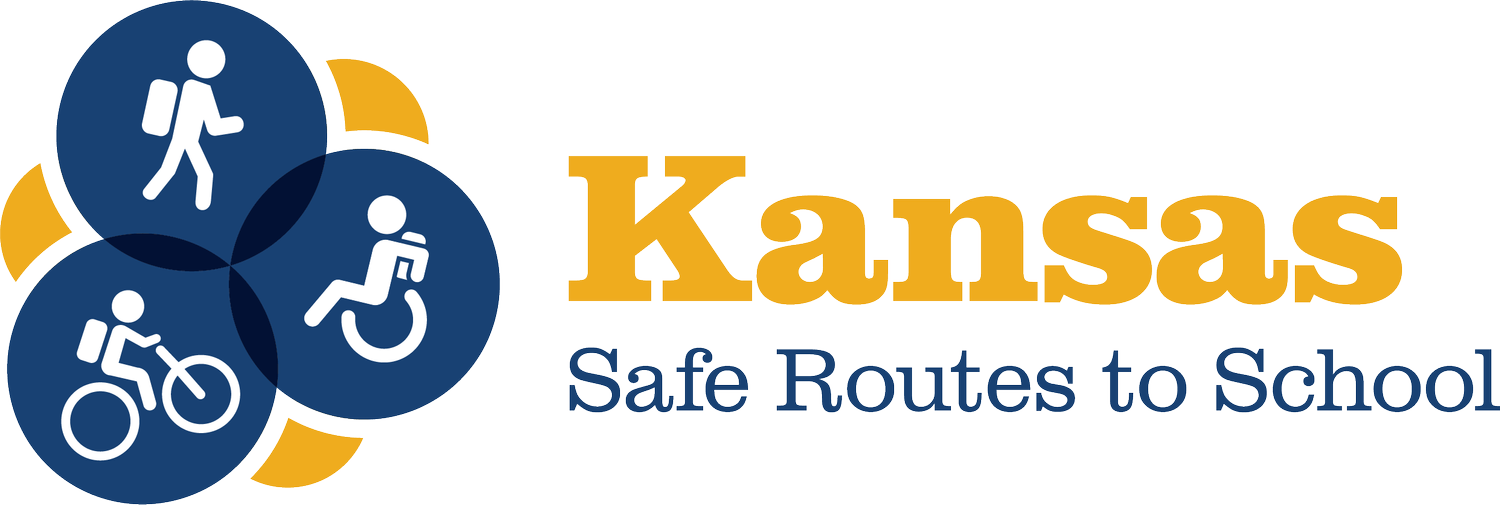About the Program
What is Safe Routes to School?
Safe Routes to School (SRTS) is a multi-faceted approach that promotes walking, biking, and rolling to school using policies, programs, and projects. The goal of SRTS is to get more kids walking, biking, and rolling to school, improve safety, and increase health and physical activity. In addition, SRTS programs seek to decrease the number of families driving to school, which can reduce traffic, improve air quality, and reduce costs for families.
All you need to do is talk to an older relative or friend about how they got to school (uphill, both ways, in the snow) to know that students today walk or bike to school less than they used to. In 1969, about 50% of all students and 90% of students who lived less than a mile from their school walked or biked. Today, that number is closer to 15%. SRTS programs throughout the country are working to reverse that trend, get students out of their cars, and get them walking, biking, or rolling to school!
Keep reading to learn about our Strategic Action Plan, SRTS Plans, KDOT’s SRTS Es, the Advisory Committee, and other SRTS-related efforts in Kansas.
KDOT SRTS Strategic Action Plan
The Kansas SRTS program is continually growing and adjusting our program to make it applicable, useful, and what students and families across Kansas need. In February 2025, we adopted our first Strategic Action Plan, which documents the program’s vision and goals. The plan also defines our path forward for future years by laying out priority strategies and actions.
The Strategic Action Plan process included engagement with the public and stakeholders to ensure that the final plan would reflect the needs, desires, and context of students and families throughout the state. Engagement included:
Statewide Online Survey. Last fall, over 200 Kansas residents and SRTS stakeholders completed an online survey that asked about current SRTS efforts, barriers, opportunities, and needs.
Safe Routes to School Advisory Committee Workshops. The SRTS Advisory Committee participated in a workshop in summer 2024 to review the proposed vision and goals, discuss strategies, and identify opportunities. In the fall, the group reviewed proposed action items and offered feedback on prioritization. In January, the committee did a final review of the document to ensure it accurately reflected SRTS needs in Kansas.
Organizational Focus Groups. The project team held four focus groups that were attended by PTA representatives and parents, public health professionals, transportation planners and engineers, and school administrators and teachers. Nearly 60 stakeholders participated in these discussions.
Check out our Strategic Action Plan here.
There have been over 50 Safe Routes to School Plans developed in Kansas since 2007. These plans help schools and communities create places and programs that help students and their families walk, bike, and roll to school.
Check out the map and links here to see if a plan has been done near you!
Recent Safe Routes to School Plans
Completed in 2025
USD 241 and 242/Wallace County
Completed in 2024
Completed in 2023
Completed in 2022
USD475/Spring Valley Elementary School (City of Junction City)
Completed in 2021
Completed in 2020
USD 284/Chase County and the City of Strong City
USD 348/City of Baldwin City, 2020
Completed in 2019
Completed in 2018
Completed in 2017
Completed in 2016
KDOT's SRTS Es
Safe Routes to School programs use a variety of approaches to meet their goals of increasing the numbers of and improving the safety for students walking, biking, and rolling to school. These approaches are commonly known as the Es.
Education
Ensure that everyone learns how to travel safely through classes, training, and events that teach the skills needed to walk, bike, and roll safely.
Encouragement
Promote and generate enthusiasm around walking and bicycling as ways to travel using events, activities, and programs.
Engineering
Provide infrastructure like sidewalks, paths, and crossings that allow people to walk, bike, and roll safely within the community and to and from schools.
Engagement
Listen to and empower students, families, teachers, community groups, and school leaders in creating a SRTS program that works uniquely for them.
Evaluation
Track progress toward achieving goals by reporting on and assessing what approaches work (or don't) and identifying program changes that can improve outcomes.
Enforcement
Deter unsafe behaviors of drivers, pedestrians and bicyclists and encourage all road users to obey traffic laws and share the road safely.
The Safe Routes to School Advisory Committee (SRAC) helps guide KDOT's SRTS Program by providing feedback, advice, and knowledge gained through professional expertise or lived experience. The committee is composed of 10-20 volunteer members representing interests including, but not limited to: state agencies that work with or who's missions align with SRTS work, bicycle and pedestrian advocacy organizations, Safe Routes to School practitioners, school districts, public health, and safety representatives, among others.
Meet the members of the SRAC here.
KDOT SRTS Advisory Committee
Other SRTS Efforts in Kansas
There are multiple efforts in Kansas that help promote walking, biking, and rolling. Click on the links below to learn more about active transportation throughout the state.
KDOT Bicycle and Pedestrian Transportation







